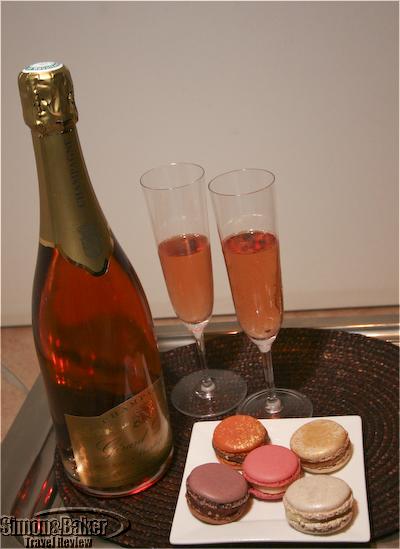by Editor | Feb 14, 2011 | Luxury Travel
By Laura Scheiber
Photos by Matthew Harris

I don’t know why I find it so much more enjoyable to read from my Kindle than from a print book, but I do. I resisted. I really did, advocating for the joys of a good ol’ fashioned book. And then everything changed when I got a Kindle as a Christmas present. Perhaps I am still in the honeymoon stage, but I don’t foresee going back to traditional books any time soon.
The Kindle, commonly referred to an e-reader or e-book, offers a portable digital replacement for print books. The screen displays one page at a time and it looks so authentic that I sometimes forget that it is not a paperback. Contrary to print books, there are buttons on the left and right-hand sides of the Kindle, allowing the reader to turn the page at the click of a button.
In general I have found the interface to be very intuitive. The menu button directs you to the Kindle store among other options, while the home button lists your personal library. The Kindle store has over 800,000 books to choose from. I like that you can sample a chapter of a book before purchasing it. This e-reader is set up so that whenever I purchase a new book, it is charged directly out of my Amazon account. My Kindle has the capacity to hold over 3,000 books and it takes approximately 60 seconds to download one book.

So far I have been impressed with the battery life. I tend to charge my Kindle about every three weeks. Battery life varies depending on the reader because electricity is only needed when turning pages (assuming the wireless feature is turned off). Since the battery life of the Kindle lasts longer with the wireless feature turned off, I only connect to the Web when shopping for new books. It takes three hours to fully charge my Kindle.
For anyone like me who loves to travel, the greatest advantage of this e-reader is having access to a bunch of books without the burden of carrying them.
My Kindle (with leather cover) weighs roughly the same as a 300-page paperback. It fits easily into a carry-on bag or purse. The dimensions measure at 7.5″ x 4.8″ x 0.335” with a 6-inch diagonal. It is about as thick as a pencil and as wide and long as a large postcard. Users who have a travel companion who also has a Kindle, can sync their accounts so that both parties have access to the same books. I foresee my Kindle being particularly useful when traveling to international places where books in English are hard to come by.

While there is an English dictionary installed for free, there are no translation tools. I hope this is a feature they will add in the future because it would be useful while traveling overseas. One downside of the Kindle when traveling by plane is that all electronic devices must be turned off during take-off and landing, including e-readers.
There are two options of the latest 6-inch Kindle model. The Kindle 3G + Wi-Fi costs $189 and offers wireless Internet coverage in over 100 countries. I opted for the $139 model which does not have this international wireless feature. However, I download books at home prior to traveling and this has worked out very well.
I like the Kindle lighted leather cover, which is sold separately at $59.99. It not only protects my e-reader, but it also has a pullout light in the upper-right hand corner. I love this feature at nighttime because I don’t have to get out of bed to turn off the lights when it is time to sleep.

While overall the device does a great job of imitating a print book, I initially found it odd that the Kindle does not display page numbers. Instead it exhibits how far, percentage-wise, I am into the book. This alternative to page numbers has to do with the fact that it is possible to change the font size. As such, it is impossible to list page numbers that consistently reflect the printed version. My only real gripe about the Kindle is that every once in awhile it loses my page number and I have to click through the chapters to find where I had previously stopped reading. Luckily this has only happened twice.
All in all, I love my Kindle Wi-Fi 6” and would absolutely recommend it to others, especially those who love to read while traveling.

by Editor | Feb 7, 2011 | Luxury Travel
Article and photos by Josette King
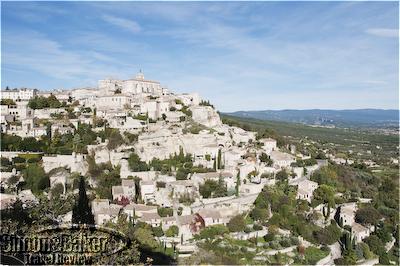
Gordes is a historic hilltop village of the Luberon
On a drive through the mountainous back roads of Provence, France a few years ago, I stopped at the top of a steep hill, mesmerized by the scenery. On the other side of the precipitous valley, clinging to a sun baked peak overlooking the glorious vistas of the Luberon, was one of the most stunning French villages perchés (hilltop villages) I had ever seen. It started at the very top of the precipice with a rambling fortified castle and church. From there, pale limestone homes and terraced gardens planted with silvery olive trees cascaded all the way to the valley floor. “Gordes,” the road sign announced, its arrow pointing in the opposite direction from the one where I was expected. I only had time to snap a few pictures before driving off with the promise that I would return, someday.
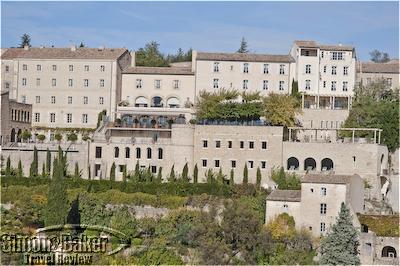
The property is perched above a steep valley
I did return recently, with Gordes as my destination this time, and La Bastide de Gordes and Spa my home. From there, I enjoyed exploring such local jewels as the remote Abbaye de Sénanque, a medieval Cistercian monastery built nine hundred years ago and still active today; and the apricot-colored village of Rousillon, surrounded by the brilliant red quarries of one of the largest ocher deposits in the world, both a mere 15 minutes away. So was the intriguing Village de Bories, a settlement of dry-stone habitations including sheep pens, bread ovens and wine vats dating back to the Bronze Age.
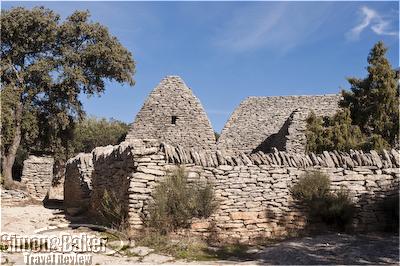
Village de Bories

Abbaye de Senanques
But best of all, there was La Bastide de Gordes itself. At the time of my hurried glimpse from the opposite side of the valley, I had mistaken it for a lovely country manor with its cloistered terraces and hanging-garden swimming pool. I loved discovering it now as a luxurious boutique hotel with a warm family-like atmosphere, peerless views of the hills of the Luberon and the Alpilles, a superb restaurant and a wonderful Sisley Spa (one of only three in France). Once again, I left with the promise that I would return, soon I hope. Visit the Simon & Baker Travel Review to read more about my visit to La Bastide de Gordes.
by Editor | Jan 14, 2011 | Luxury Travel
On a recent visit to Paris, France one of our teams strolled into the Hotel Ritz on the Place Vendome seeking to browse the menu for L’Espadon, the hotel’s gourmet restaurant, where they had made reservations to dine later in the week. Nearly every hotel in Paris that hosts a fine dining restaurant proudly displays the menu in a glass case outside the entrance to entice potential diners. On approaching the entrance to the Paris Ritz hotel, the doorman took on the demeanor of a security guard and asked them what their business was at the hotel. Once they explained their purpose he allowed them to enter. Just inside the entrance, another man with the demeanor of a security guard was watching the people moving in the lobby and called to our team as they moved toward the restaurant. In terse language he said they could not approach the restaurant and that there was no menu available near the restaurant entrance.
He indicated that if they wished further information they should go to the front desk. On arriving at the front desk and asking to see the menu the young lady who greeted them said they should go to the restaurant and indicated where it was. Two additional desk personnel approached and informed our team that the only information available was on the hotel website (apparently they felt the need to outnumber our team of two, or just had nothing better to do at the time). Truly service oriented staff would have printed the menu from the website using the equipment in front of them rather than simply sending restaurant guests back out into the Place Vendome with nothing but a negative impression. The hotel’s staff attitude and service belied the “When a dream comes true” concept touted on the hotel website.
Our team left the hotel and made plans to dine elsewhere. In a city filled with fine dining venues it was a matter of minutes before they secured reservations at an outstanding gourmet restaurant. We can only imagine that L’Espadon is able to draw an adequate clientele from the hotel guests at the Ritz as the Hotel Ritz in Paris was singularly unwelcoming and borderline hostile at the very idea of non-guests passing through their hallowed halls to visit their fine dining restaurant.
by Editor | Dec 3, 2010 | Luxury Travel

As Media Partners of the World Travel & Tourism Council’s (WTTC) 2011 Tourism for Tomorrow Awards we share this message from the 2011 Tourism for Tomorrow Awards organizers that we think may interest you:
Apply today!
Only one week to go until the 10 December deadline for applications for the World Travel & Tourism Council’s (WTTC) 2011 Tourism for Tomorrow Awards.
WTTC invites tourism businesses and destinations worldwide to enter in one of the four categories: Global Tourism Business, Conservation, Community Benefit and Destination Stewardship, showcasing best practice in sustainable tourism. Applications may be submitted online on www.tourismfortomorrow.com/Apply/.
The Global Tourism Business award is the leadership recognition in best practices in sustainable tourism at a large company level with at least 500 full-time employees and operating in more than one country
WTTC’s foremost awards, which include an international panel of expert judges and a rigorous on-site evaluation process, recognise and celebrate these advances in sustainable best practices. Finalists and winners will receive worldwide exposure, setting the standard for sustainable practices and projects.
Due to a three-step stringent judging process, the Tourism for Tomorrow Awards have achieved growing levels of respect among key audiences – the industry, governments and the international media. Winners and Finalists will be publicly recognised during a special ceremony at the 11th Global Travel & Tourism Summit held from 17-19 May 2011 in Las Vegas, USA, in the presence of government and industry leaders. For additional information visit www.globaltraveltourism.com
by Editor | Nov 29, 2010 | Luxury Travel
Article and photos by Elena del Valle
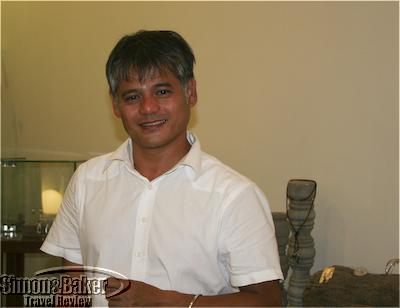
Cambodian silversmith Ly Pisith in his shop
As I sat across from him early one evening in the boutique I noticed his calm demeanor in between the constant interruptions of customers. I sensed kindness, a certain sadness and a quiet strength. Beyond that it was impossible to guess what the welcoming and handsome man was thinking. We spoke easily, switching between languages and topics as the ebb and flow of customers allowed.
At first I didn’t know what stirred disquiet within me. The store was a labor of love filed with distinctive locally inspired pieces on display. Every one of them was a part of a story, his story, I discovered later as we spoke.

His shop is located in the heart of Siem Reap, Cambodia
Ly Pisith lived a harrowing childhood in Cambodia. After escaping the Khmer Rouge, the despotic regime that killed everyone in his family and forcibly recruited him, he grew up on the streets of the capital city. From the urban center of the country he walked miles upon miles to the border with Thailand where he was taken to a French Red Cross camp.
From there things improved. Eventually he moved to France where he attended school. He studied at the Institut Universitaire de Technologie in Bordeaux and took courses in graphic art and decoration at the Beaux Art de Paris. In time he became successful designing eye wear at Alain Mikkli and Stark, he told me softly in French. But the ghosts of his past haunted him, driving him to return to the land where he lost everything and suffered so profoundly in search of peace and a respite. He believes the path to what he seeks is in Siem Reap, Cambodia confronting the past that is no longer.
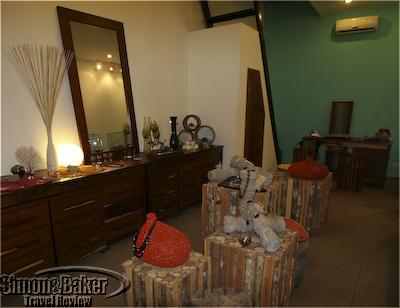
The Garden of Desire displays were locally inspired and made with local artifacts
“I have always a passion in jewelery design. I started young but the designs were for myself and close friends only. It was only two years back when I decided to pursue jewelery design, open up a gallery and made a new career move,” he said.
In 2008, he opened Garden of Desire, a silver jewelry boutique in the heart of Siem Reap near the central market. In the well lit shop decorated with local materials including wood and art based on the designs of the nearby world famous Angkor Temples he sells art as jewelry in contemporary designs. An executive at my hotel recommended the shop after explaining that it was the only jeweler in town he trusted to be reputable due to the many fake precious stones being sold as the real thing even in high end stores. Almost everyone I asked echoed those sentiments. When I asked the shop owner about the situation he agreed it was a widespread problem and the reason he only worked with semi-precious stones.
His designs are wearable art with elements of storytelling; made to be comfortable to wear and stylish. His art is “about encasements of personal stories and reflections.” Cages are a repetitive feature in his work, he explained, because so much of his life is associated with being constrained in some way. Even at the Red Cross camp where he found help he was imprisoned since he was not allowed to leave.

An intricate silver necklace, one of the Caged designs
“The jewelry doesn’t have to be nice. It’s about their personality. They find the right something that tells you something perfectly takes over you. It really has to be something that brings out you. This is my conception of jewelry; and jewelry has a feel, a look,” he said, explaining that it is not necessary for jewelry to make the wearer feel good or nice; he seeks to provide items his customer identify with immediately.
He went on to say that jewelry can express feelings of pain, anguish, and the anxiety of feeling boxed in; his customers browse through the store and find the item they identify with right away. He shares his feelings and his experiences in his jewelry and his customers find the ones that resonate with them.
A couple purchased a ring while I was at the store. They walked around and waited two hours while it was sized rather than give up on the purchase. He sees that desire and that determination often among his customers, he told me when I asked how customers respond to his jewelry.
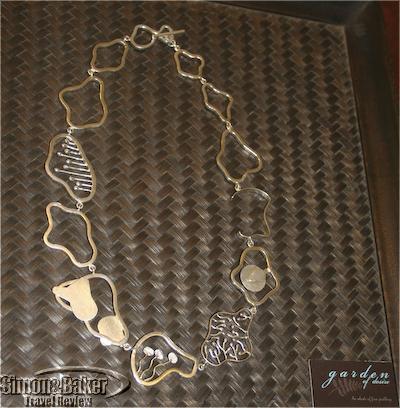
Sculpture as jewelry
“I am always most willing to explain my works to my customers who are keen in my creations. After hearing about the ideas behind their purchase, they are often surprised and value the pieces even more. But my creations can be appreciated on different levels; from the designs to forms,” said the Cambodian artist who was partly self taught in France.
“I am always curious about working with new materials and often I learned from books and through experimentation. I also work with Cambodian artisans. It is a two way learning journey for us. We come up with our own methods,” he said when asked how he learned his trade.

Intricate and thought provoking designs
Some of his series include Weather, about the environment including clouds, rain, organisms and the ozone; Cage which consists of two necklaces. The first speaks of humans trying to control or take over nature. The second necklace illustrates nature overpowering humans and resisting interventions. Series 1 Can You Hear Me? is an abstract image of a land mine victim. Series 2 Can You Hear Me? is also an abstract portrait of a land mine victim. Here the inner voice is expressed through the facial expression, a silent scream.
“Upon seeing the victims and knowing their personal stories, I was intrigued to create a piece of jewelry. This piece shows the figure of the victim. Standing on only one good leg and hand reaching out,” he said.
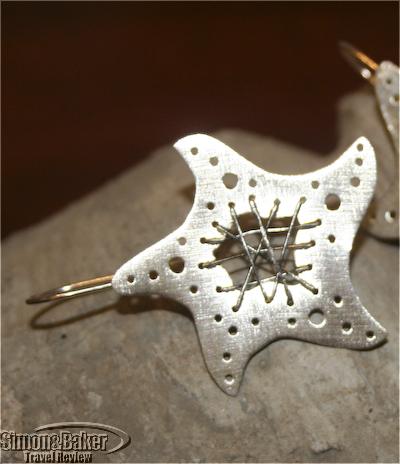
Out of the ordinary star earrings
“Having lived in France for most of my life and traveling around the globe, Cambodia and especially Siem Reap is still close to my heart. I was born in Phnom Penh and travel(ed) to France after the war. Siem Reap is such a charming place with the temples where I can seek peace. I lead a simple yet meaningful life creating my works. I do miss a little the city buzz from time to time where you have everything,” Ly said, explaining that in the future he plans to continue experimenting with new materials beyond silver. Garden of Desire, The Passage-Old Market Area, Siem Reap, Kingdom of Cambodia, +855 12 319116, www.gardenofdesire.wordpress.com, gardenofdesire@ymail.com










